2010 INFINITI QX56 ignition
[x] Cancel search: ignitionPage 3781 of 4210
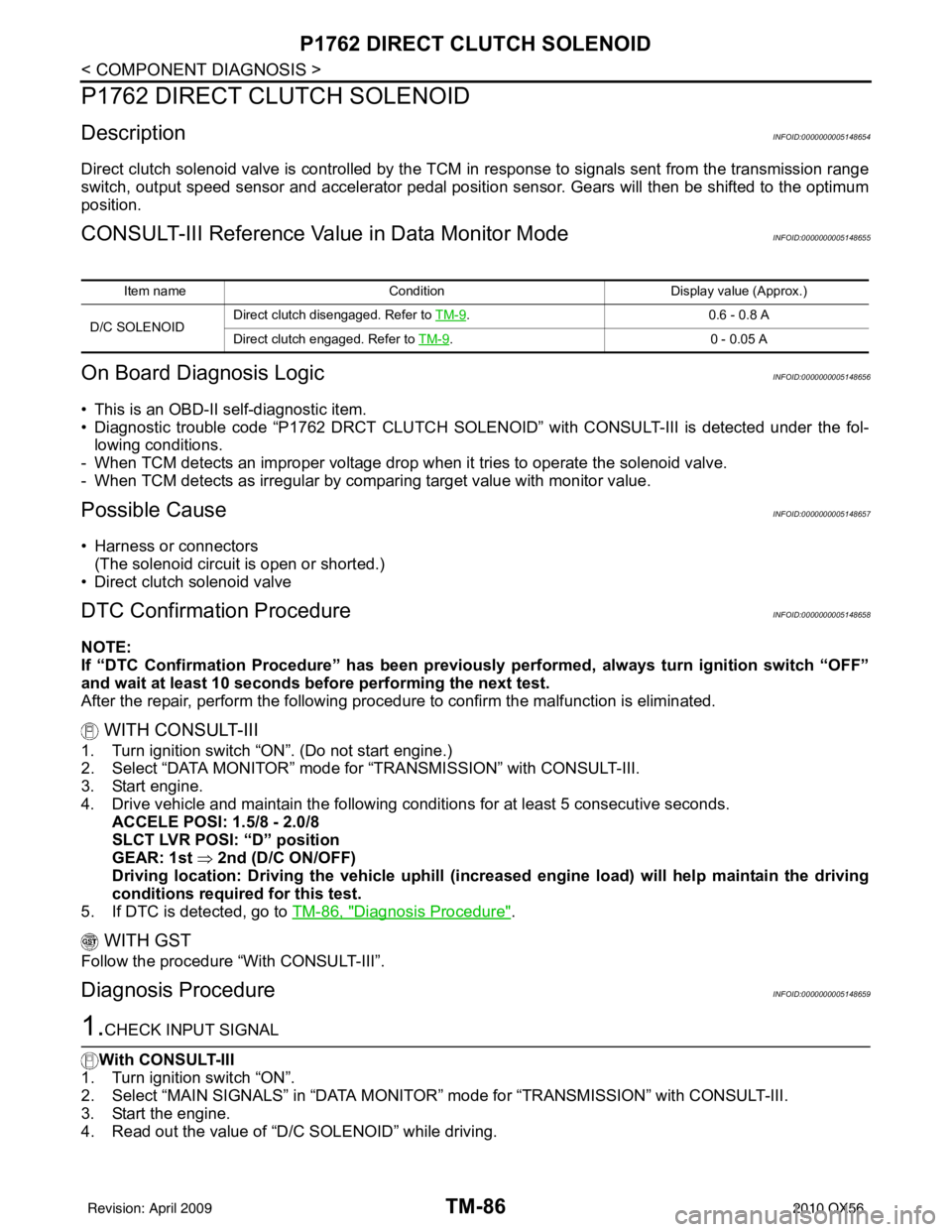
TM-86
< COMPONENT DIAGNOSIS >
P1762 DIRECT CLUTCH SOLENOID
P1762 DIRECT CLUTCH SOLENOID
DescriptionINFOID:0000000005148654
Direct clutch solenoid valve is controlled by the TCM in response to signals sent from the transmission range
switch, output speed sensor and accelerator pedal position sensor. Gears will then be shifted to the optimum
position.
CONSULT-III Reference Value in Data Monitor ModeINFOID:0000000005148655
On Board Diagn osis LogicINFOID:0000000005148656
• This is an OBD-II self-diagnostic item.
• Diagnostic trouble code “P1762 DRCT CLUTCH SOLENOID” with CONSULT-III is detected under the fol-
lowing conditions.
- When TCM detects an improper voltage drop when it tries to operate the solenoid valve.
- When TCM detects as irregular by comparing target value with monitor value.
Possible CauseINFOID:0000000005148657
• Harness or connectors (The solenoid circuit is open or shorted.)
• Direct clutch solenoid valve
DTC Confirmation ProcedureINFOID:0000000005148658
NOTE:
If “DTC Confirmation Procedure” has been previously performed, always turn ignition switch “OFF”
and wait at least 10 seconds before performing the next test.
After the repair, perform the following proc edure to confirm the malfunction is eliminated.
WITH CONSULT-III
1. Turn ignition switch “ON”. (Do not start engine.)
2. Select “DATA MONITOR” mode for “TRANSMISSION” with CONSULT-III.
3. Start engine.
4. Drive vehicle and maintain the following conditions for at least 5 consecutive seconds. ACCELE POSI: 1.5/8 - 2.0/8
SLCT LVR POSI: “D” position
GEAR: 1st ⇒ 2nd (D/C ON/OFF)
Driving location: Driving the vehicle uphill (increased engine load) will help maintain the driving
conditions required for this test.
5. If DTC is detected, go to TM-86, "
Diagnosis Procedure".
WITH GST
Follow the procedure “With CONSULT-III”.
Diagnosis ProcedureINFOID:0000000005148659
1.CHECK INPUT SIGNAL
With CONSULT-III
1. Turn ignition switch “ON”.
2. Select “MAIN SIGNALS” in “DATA MONITO R” mode for “TRANSMISSION” with CONSULT-III.
3. Start the engine.
4. Read out the value of “D/C SOLENOID” while driving.
Item name Condition Display value (Approx.)
D/C SOLENOID Direct clutch disengaged. Refer to
TM-9
. 0.6 - 0.8 A
Direct clutch engaged. Refer to TM-9
. 0 - 0.05 A
Revision: April 20092010 QX56
Page 3783 of 4210
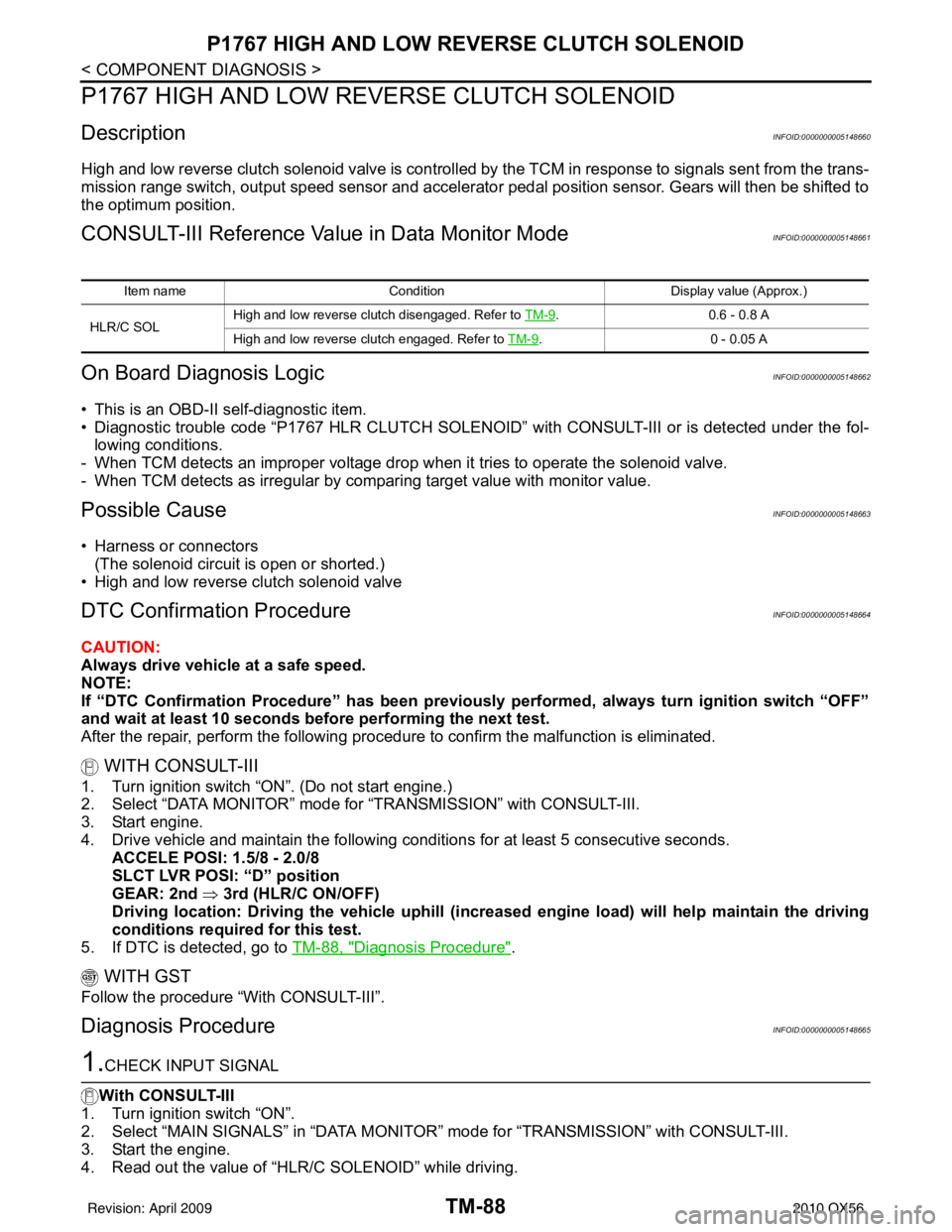
TM-88
< COMPONENT DIAGNOSIS >
P1767 HIGH AND LOW REVERSE CLUTCH SOLENOID
P1767 HIGH AND LOW REVERSE CLUTCH SOLENOID
DescriptionINFOID:0000000005148660
High and low reverse clutch solenoid valve is controlled by the TCM in response to signals sent from the trans-
mission range switch, output speed sensor and accelerato r pedal position sensor. Gears will then be shifted to
the optimum position.
CONSULT-III Reference Value in Data Monitor ModeINFOID:0000000005148661
On Board Diagn osis LogicINFOID:0000000005148662
• This is an OBD-II self-diagnostic item.
• Diagnostic trouble code “P1767 HLR CLUTCH SOLENOID” with CONSULT-III or is detected under the fol-
lowing conditions.
- When TCM detects an improper voltage drop when it tries to operate the solenoid valve.
- When TCM detects as irregular by comparing target value with monitor value.
Possible CauseINFOID:0000000005148663
• Harness or connectors (The solenoid circuit is open or shorted.)
• High and low reverse clutch solenoid valve
DTC Confirmation ProcedureINFOID:0000000005148664
CAUTION:
Always drive vehicle at a safe speed.
NOTE:
If “DTC Confirmation Procedure” has been previously performed, always turn ignition switch “OFF”
and wait at least 10 seconds before performing the next test.
After the repair, perform the following proc edure to confirm the malfunction is eliminated.
WITH CONSULT-III
1. Turn ignition switch “ON”. (Do not start engine.)
2. Select “DATA MONITOR” mode for “TRANSMISSION” with CONSULT-III.
3. Start engine.
4. Drive vehicle and maintain the following conditions for at least 5 consecutive seconds. ACCELE POSI: 1.5/8 - 2.0/8
SLCT LVR POSI: “D” position
GEAR: 2nd ⇒ 3rd (HLR/C ON/OFF)
Driving location: Driving the vehicle uphill (increased engine load) will help maintain the driving
conditions required for this test.
5. If DTC is detected, go to TM-88, "
Diagnosis Procedure".
WITH GST
Follow the procedure “With CONSULT-III”.
Diagnosis ProcedureINFOID:0000000005148665
1.CHECK INPUT SIGNAL
With CONSULT-III
1. Turn ignition switch “ON”.
2. Select “MAIN SIGNALS” in “DATA MONITO R” mode for “TRANSMISSION” with CONSULT-III.
3. Start the engine.
4. Read out the value of “HLR/C SOLENOID” while driving.
Item name Condition Display value (Approx.)
HLR/C SOL High and low reverse clutch disengaged. Refer to TM-9
.
0.6 - 0.8 A
High and low reverse clutch engaged. Refer to TM-9
.0 - 0.05 A
Revision: April 20092010 QX56
Page 3785 of 4210
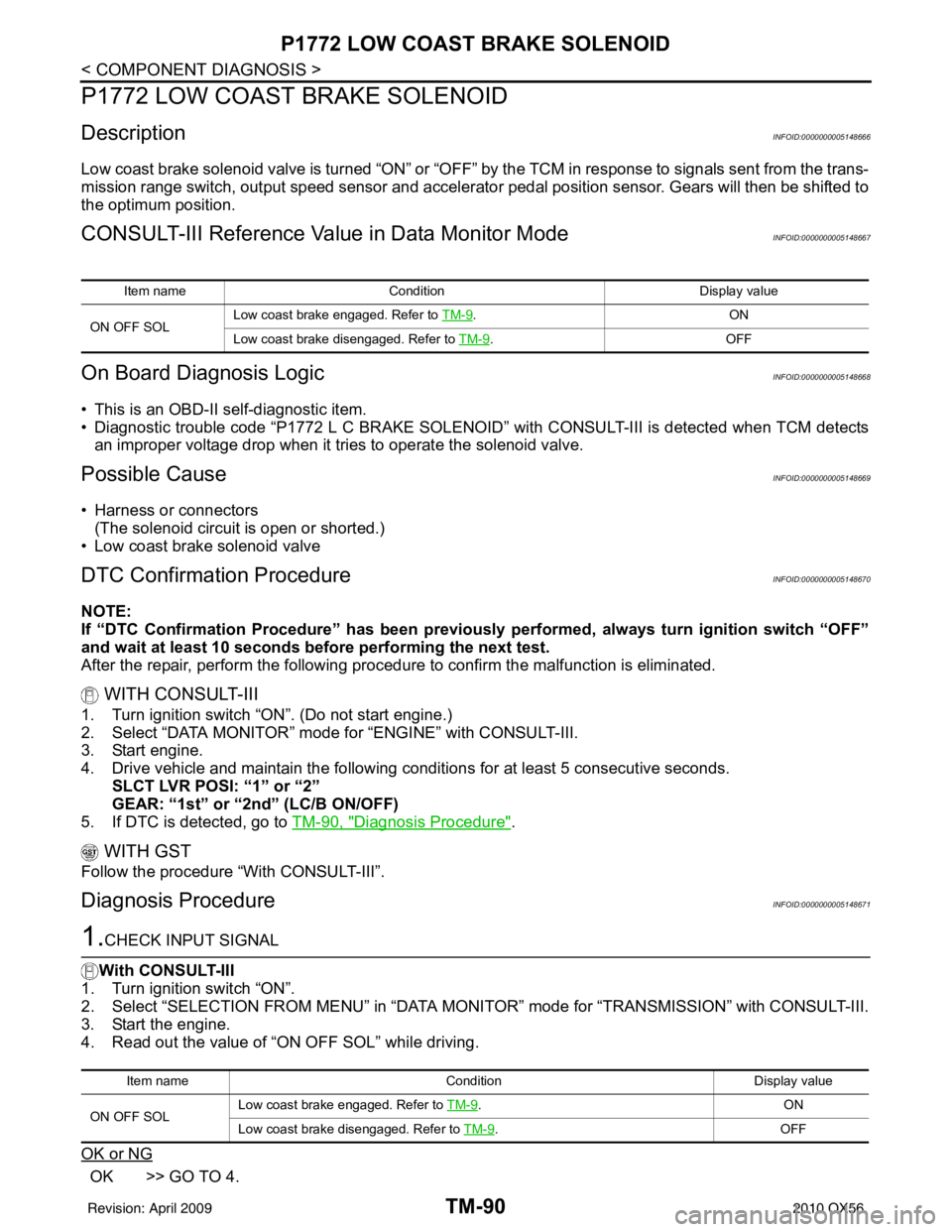
TM-90
< COMPONENT DIAGNOSIS >
P1772 LOW COAST BRAKE SOLENOID
P1772 LOW COAST BRAKE SOLENOID
DescriptionINFOID:0000000005148666
Low coast brake solenoid valve is turned “ON” or “OFF” by the TCM in response to signals sent from the trans-
mission range switch, output speed sensor and accelerator pedal position sensor. Gears will then be shifted to
the optimum position.
CONSULT-III Reference Value in Data Monitor ModeINFOID:0000000005148667
On Board Diagn osis LogicINFOID:0000000005148668
• This is an OBD-II self-diagnostic item.
• Diagnostic trouble code “P1772 L C BRAKE SOLENOID” with CONSULT-III is detected when TCM detects
an improper voltage drop when it tries to operate the solenoid valve.
Possible CauseINFOID:0000000005148669
• Harness or connectors (The solenoid circuit is open or shorted.)
• Low coast brake solenoid valve
DTC Confirmation ProcedureINFOID:0000000005148670
NOTE:
If “DTC Confirmation Procedure” has been previously performed, always turn ignition switch “OFF”
and wait at least 10 seconds before performing the next test.
After the repair, perform the following proc edure to confirm the malfunction is eliminated.
WITH CONSULT-III
1. Turn ignition switch “ON”. (Do not start engine.)
2. Select “DATA MONITOR” mode for “ENGINE” with CONSULT-III.
3. Start engine.
4. Drive vehicle and maintain the following conditions for at least 5 consecutive seconds.
SLCT LVR POSI: “1” or “2”
GEAR: “1st” or “2nd” (LC/B ON/OFF)
5. If DTC is detected, go to TM-90, "
Diagnosis Procedure".
WITH GST
Follow the procedure “With CONSULT-III”.
Diagnosis ProcedureINFOID:0000000005148671
1.CHECK INPUT SIGNAL
With CONSULT-III
1. Turn ignition switch “ON”.
2. Select “SELECTION FROM MENU” in “DATA MONI TOR” mode for “TRANSMISSION” with CONSULT-III.
3. Start the engine.
4. Read out the value of “ON OFF SOL” while driving.
OK or NG
OK >> GO TO 4.
Item name Condition Display value
ON OFF SOL Low coast brake engaged. Refer to
TM-9
.O N
Low coast brake disengaged. Refer to TM-9
.O FF
Item name Condition Display value
ON OFF SOL Low coast brake engaged. Refer to
TM-9
.O N
Low coast brake disengaged. Refer to TM-9
.O FF
Revision: April 20092010 QX56
Page 3787 of 4210
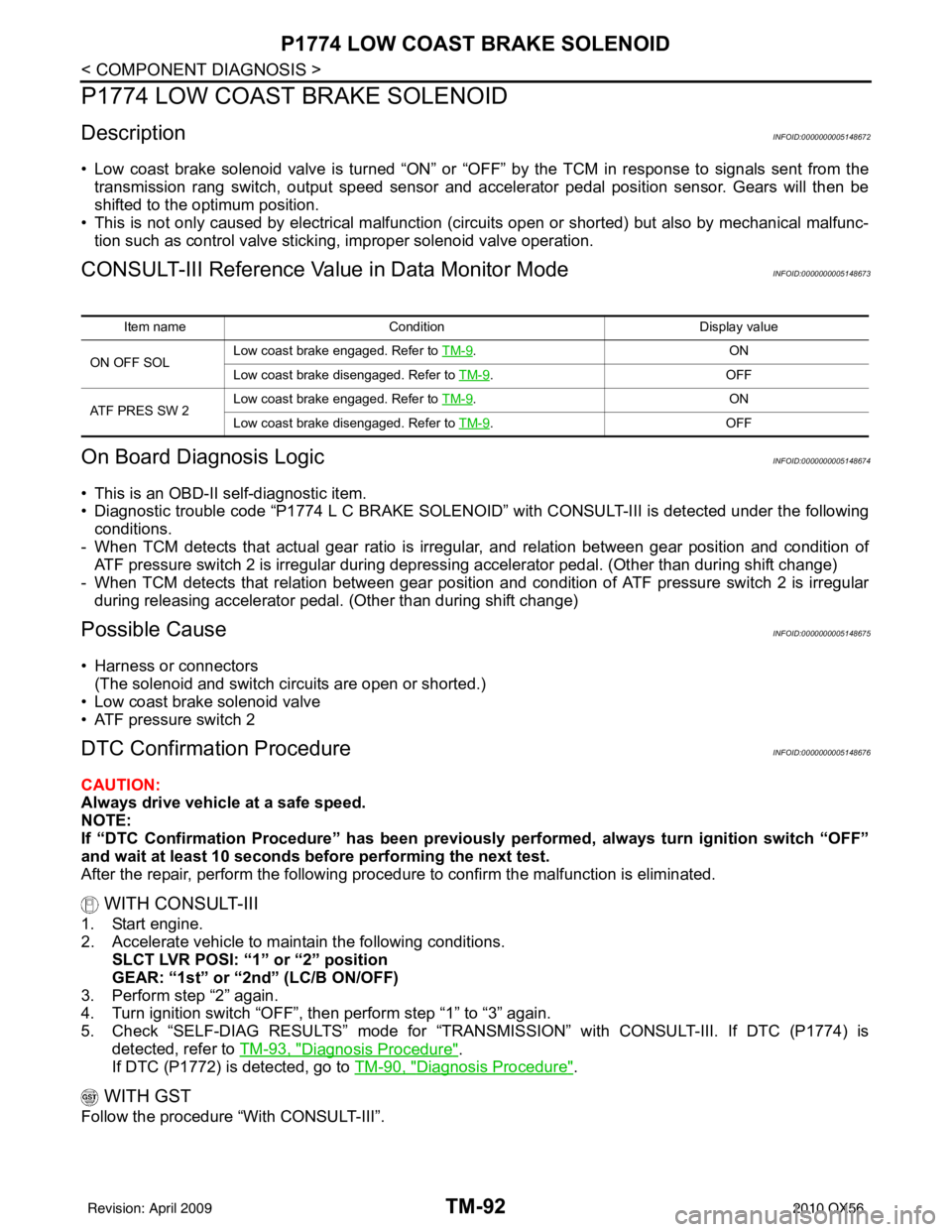
TM-92
< COMPONENT DIAGNOSIS >
P1774 LOW COAST BRAKE SOLENOID
P1774 LOW COAST BRAKE SOLENOID
DescriptionINFOID:0000000005148672
• Low coast brake solenoid valve is turned “ON” or “OFF” by the TCM in response to signals sent from the
transmission rang switch, output speed sensor and accelerator pedal position sensor. Gears will then be
shifted to the optimum position.
• This is not only caused by electrical malfunction (circuits open or shorted) but also by mechanical malfunc- tion such as control valve sticking, improper solenoid valve operation.
CONSULT-III Reference Value in Data Monitor ModeINFOID:0000000005148673
On Board Diagn osis LogicINFOID:0000000005148674
• This is an OBD-II self-diagnostic item.
• Diagnostic trouble code “P1774 L C BRAKE SOLENOID” with CONSULT-III is detected under the following
conditions.
- When TCM detects that actual gear ratio is irregular, and relation between gear position and condition of ATF pressure switch 2 is irregular during depressing accelerator pedal. (Other than during shift change)
- When TCM detects that relation between gear position and condition of ATF pressure switch 2 is irregular
during releasing accelerator pedal. (Other than during shift change)
Possible CauseINFOID:0000000005148675
• Harness or connectors (The solenoid and switch circuits are open or shorted.)
• Low coast brake solenoid valve
• ATF pressure switch 2
DTC Confirmation ProcedureINFOID:0000000005148676
CAUTION:
Always drive vehicle at a safe speed.
NOTE:
If “DTC Confirmation Procedure” has been previously performed, always turn ignition switch “OFF”
and wait at least 10 seconds before performing the next test.
After the repair, perform the following proc edure to confirm the malfunction is eliminated.
WITH CONSULT-III
1. Start engine.
2. Accelerate vehicle to maintain the following conditions.
SLCT LVR POSI: “1” or “2” position
GEAR: “1st” or “2nd” (LC/B ON/OFF)
3. Perform step “2” again.
4. Turn ignition switch “OFF”, then perform step “1” to “3” again.
5. Check “SELF-DIAG RESULTS” mode for “TRANSMISSION” with CONSULT-III. If DTC (P1774) is detected, refer to TM-93, "
Diagnosis Procedure".
If DTC (P1772) is detected, go to TM-90, "
Diagnosis Procedure".
WITH GST
Follow the procedure “With CONSULT-III”.
Item name Condition Display value
ON OFF SOL Low coast brake engaged. Refer to
TM-9
.O N
Low coast brake disengaged. Refer to TM-9
.O FF
ATF PRES SW 2 Low coast brake engaged. Refer to
TM-9
.O N
Low coast brake disengaged. Refer to TM-9
.O FF
Revision: April 20092010 QX56
Page 3789 of 4210
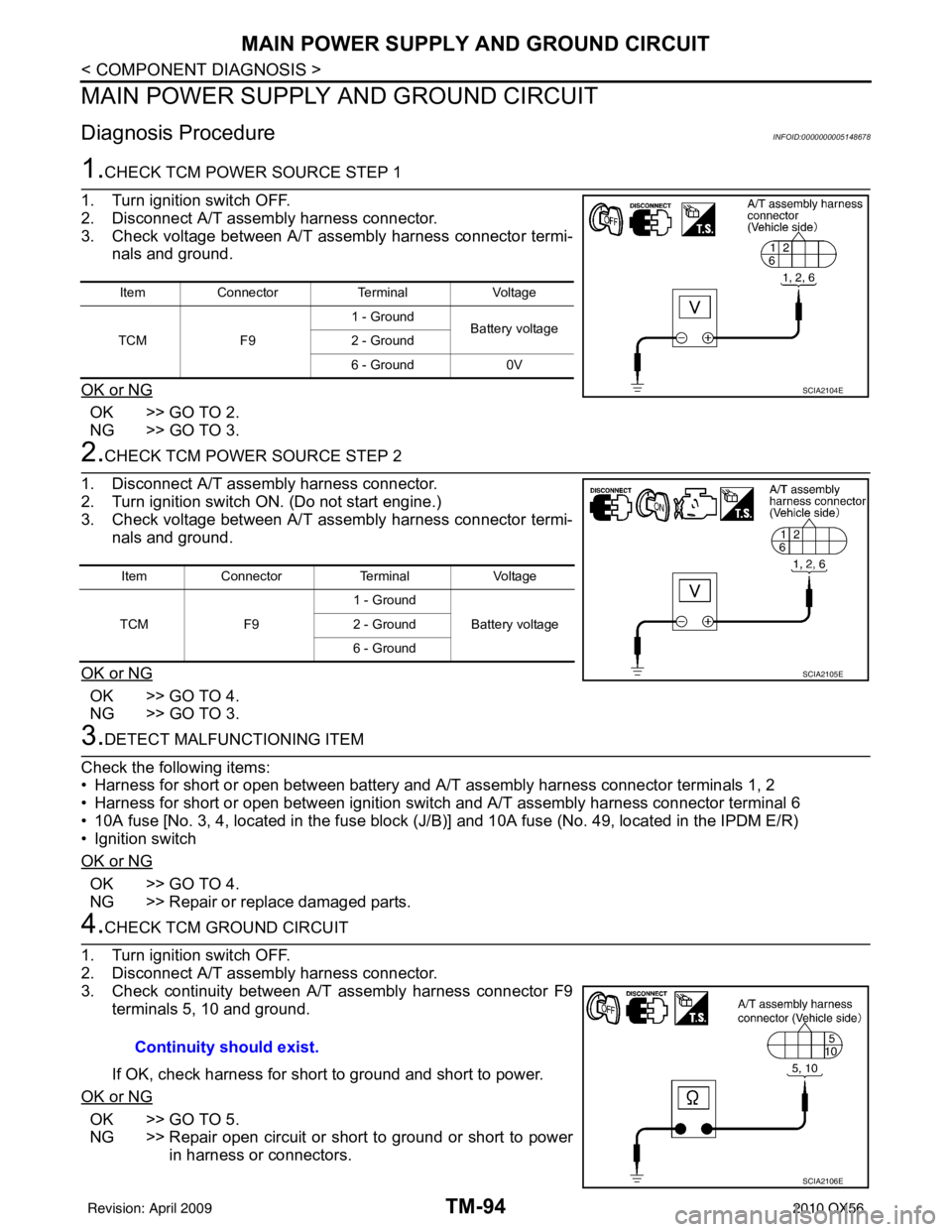
TM-94
< COMPONENT DIAGNOSIS >
MAIN POWER SUPPLY AND GROUND CIRCUIT
MAIN POWER SUPPLY AND GROUND CIRCUIT
Diagnosis ProcedureINFOID:0000000005148678
1.CHECK TCM POWER SOURCE STEP 1
1. Turn ignition switch OFF.
2. Disconnect A/T assembly harness connector.
3. Check voltage between A/T assembly harness connector termi- nals and ground.
OK or NG
OK >> GO TO 2.
NG >> GO TO 3.
2.CHECK TCM POWER SOURCE STEP 2
1. Disconnect A/T assembly harness connector.
2. Turn ignition switch ON. (Do not start engine.)
3. Check voltage between A/T assembly harness connector termi- nals and ground.
OK or NG
OK >> GO TO 4.
NG >> GO TO 3.
3.DETECT MALFUNCTIONING ITEM
Check the following items:
• Harness for short or open between battery and A/T assembly harness connector terminals 1, 2
• Harness for short or open between ignition switch and A/T assembly harness connector terminal 6
• 10A fuse [No. 3, 4, located in the fuse block (J /B)] and 10A fuse (No. 49, located in the IPDM E/R)
• Ignition switch
OK or NG
OK >> GO TO 4.
NG >> Repair or replace damaged parts.
4.CHECK TCM GROUND CIRCUIT
1. Turn ignition switch OFF.
2. Disconnect A/T assembly harness connector.
3. Check continuity between A/T assembly harness connector F9 terminals 5, 10 and ground.
If OK, check harness for short to ground and short to power.
OK or NG
OK >> GO TO 5.
NG >> Repair open circuit or short to ground or short to power in harness or connectors.
Item Connector TerminalVoltage
TCM F91 - Ground
Battery voltage
2 - Ground
6 - Ground 0V
SCIA2104E
ItemConnector TerminalVoltage
TCM F91 - Ground
Battery voltage
2 - Ground
6 - Ground
SCIA2105E
Continuity should exist.
SCIA2106E
Revision: April 20092010 QX56
Page 3791 of 4210
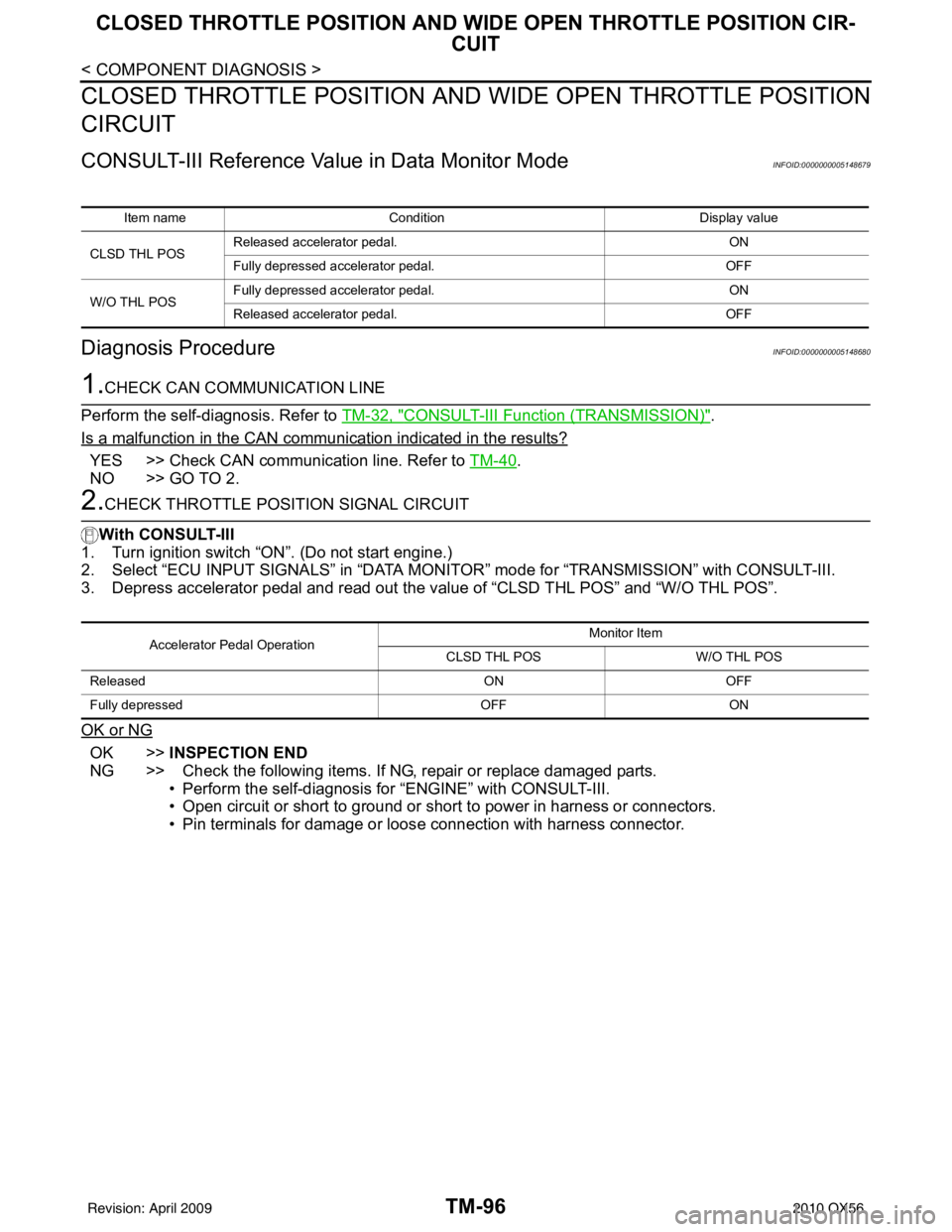
TM-96
< COMPONENT DIAGNOSIS >
CLOSED THROTTLE POSITION AND WIDE OPEN THROTTLE POSITION CIR-
CUIT
CLOSED THROTTLE POSITION AND WIDE OPEN THROTTLE POSITION
CIRCUIT
CONSULT-III Reference Value in Data Monitor ModeINFOID:0000000005148679
Diagnosis ProcedureINFOID:0000000005148680
1.CHECK CAN COMMUNICATION LINE
Perform the self-diagnosis. Refer to TM-32, "
CONSULT-III Function (TRANSMISSION)".
Is a malfunction in the CAN communication indicated in the results?
YES >> Check CAN communication line. Refer to TM-40.
NO >> GO TO 2.
2.CHECK THROTTLE POSI TION SIGNAL CIRCUIT
With CONSULT-III
1. Turn ignition switch “ON”. (Do not start engine.)
2. Select “ECU INPUT SIGNALS” in “DATA MONI TOR” mode for “TRANSMISSION” with CONSULT-III.
3. Depress accelerator pedal and read out the value of “CLSD THL POS” and “W/O THL POS”.
OK or NG
OK >> INSPECTION END
NG >> Check the following items. If NG, repair or replace damaged parts. • Perform the self-diagnosis for “ENGINE” with CONSULT-III.
• Open circuit or short to ground or shor t to power in harness or connectors.
• Pin terminals for damage or loos e connection with harness connector.
Item name Condition Display value
CLSD THL POS Released accelerator pedal.
ON
Fully depressed accelerator pedal. OFF
W/O THL POS Fully depressed accelerator pedal.
ON
Released accelerator pedal. OFF
Accelerator Pedal OperationMonitor Item
CLSD THL POS W/O THL POS
Released ONOFF
Fully depressed OFFON
Revision: April 20092010 QX56
Page 3792 of 4210
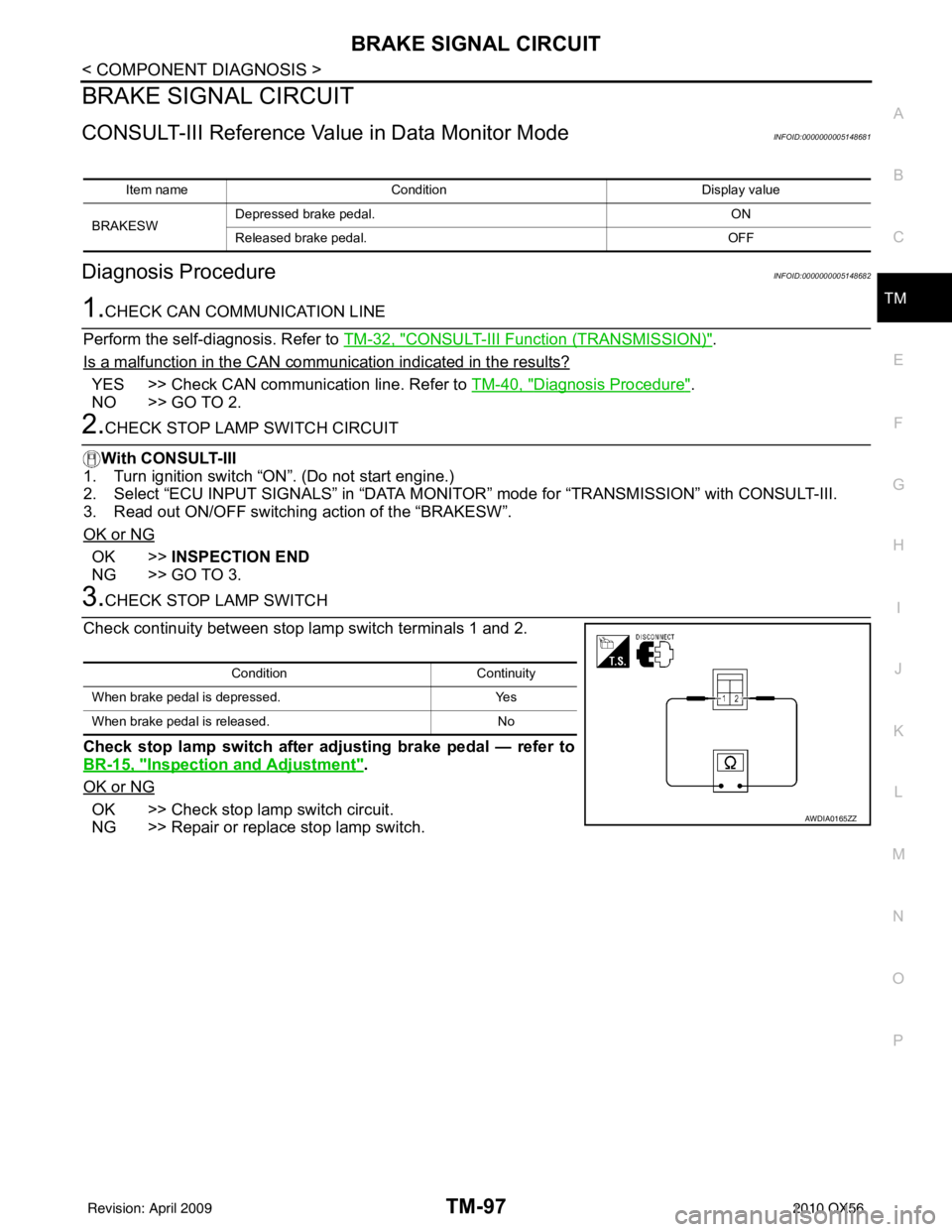
BRAKE SIGNAL CIRCUITTM-97
< COMPONENT DIAGNOSIS >
CEF
G H
I
J
K L
M A
B
TM
N
O P
BRAKE SIGNAL CIRCUIT
CONSULT-III Reference Val ue in Data Monitor ModeINFOID:0000000005148681
Diagnosis ProcedureINFOID:0000000005148682
1.CHECK CAN COMMUNICATION LINE
Perform the self-diagnosis. Refer to TM-32, "
CONSULT-III Function (TRANSMISSION)".
Is a malfunction in the CAN communication indicated in the results?
YES >> Check CAN communication line. Refer to TM-40, "Diagnosis Procedure".
NO >> GO TO 2.
2.CHECK STOP LAMP SWITCH CIRCUIT
With CONSULT-III
1. Turn ignition switch “ON”. (Do not start engine.)
2. Select “ECU INPUT SIGNALS” in “DATA MONITO R” mode for “TRANSMISSION” with CONSULT-III.
3. Read out ON/OFF switching action of the “BRAKESW”.
OK or NG
OK >> INSPECTION END
NG >> GO TO 3.
3.CHECK STOP LAMP SWITCH
Check continuity between stop lamp switch terminals 1 and 2.
Check stop lamp switch after adjusting brake pedal — refer to
BR-15, "
Inspection and Adjustment".
OK or NG
OK >> Check stop lamp switch circuit.
NG >> Repair or replace stop lamp switch.
Item name Condition Display value
BRAKESW Depressed brake pedal.
ON
Released brake pedal. OFF
ConditionContinuity
When brake pedal is depressed. Yes
When brake pedal is released. No
AWDIA0165ZZ
Revision: April 20092010 QX56
Page 3793 of 4210
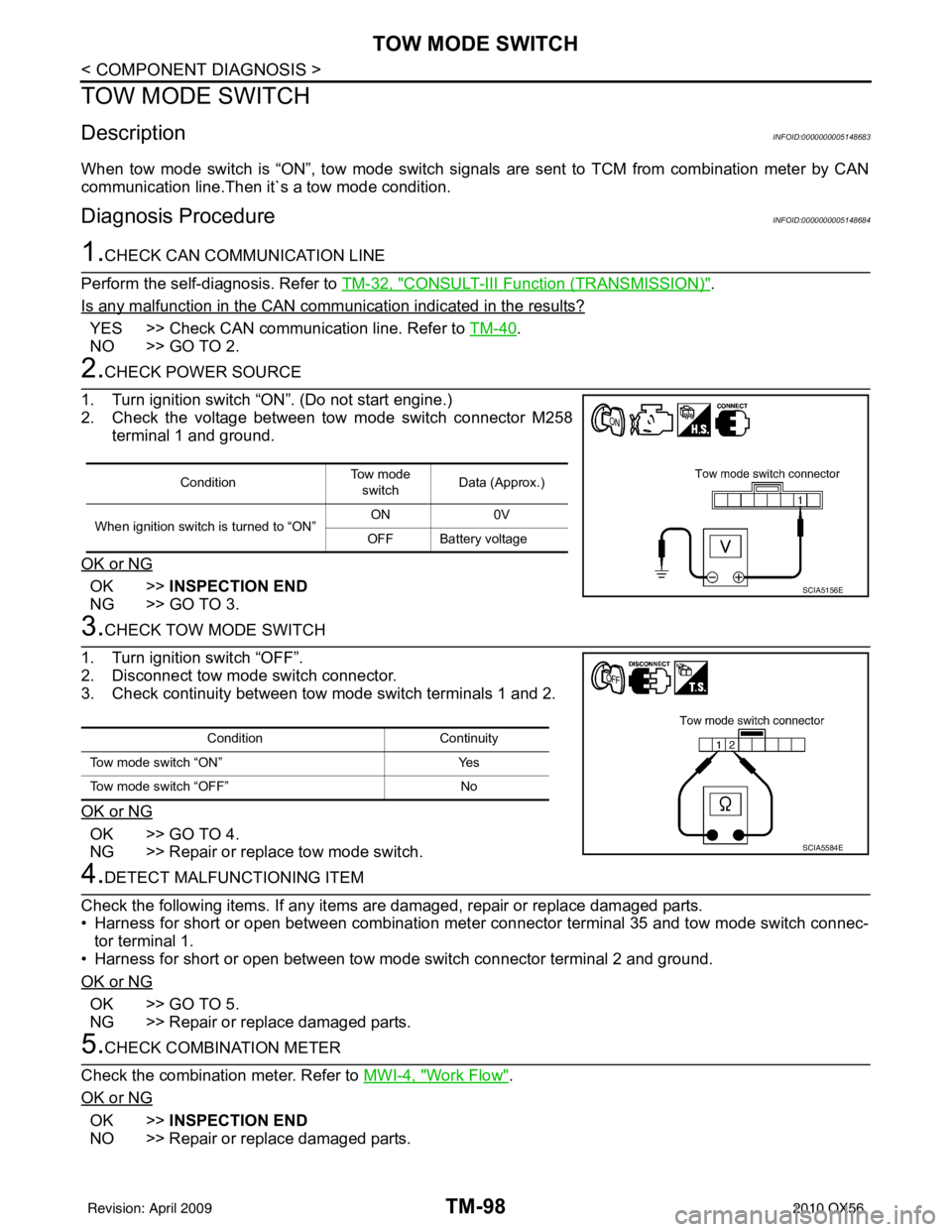
TM-98
< COMPONENT DIAGNOSIS >
TOW MODE SWITCH
TOW MODE SWITCH
DescriptionINFOID:0000000005148683
When tow mode switch is “ON”, tow mode switch signals are sent to TCM from combination meter by CAN
communication line.Then it`s a tow mode condition.
Diagnosis ProcedureINFOID:0000000005148684
1.CHECK CAN COMMUNICATION LINE
Perform the self-diagnosis. Refer to TM-32, "
CONSULT-III Function (TRANSMISSION)".
Is any malfunction in the CAN communication indicated in the results?
YES >> Check CAN communication line. Refer to TM-40.
NO >> GO TO 2.
2.CHECK POWER SOURCE
1. Turn ignition switch “ON”. (Do not start engine.)
2. Check the voltage between tow mode switch connector M258 terminal 1 and ground.
OK or NG
OK >> INSPECTION END
NG >> GO TO 3.
3.CHECK TOW MODE SWITCH
1. Turn ignition switch “OFF”.
2. Disconnect tow mode switch connector.
3. Check continuity between tow mode switch terminals 1 and 2.
OK or NG
OK >> GO TO 4.
NG >> Repair or replace tow mode switch.
4.DETECT MALFUNCTIONING ITEM
Check the following items. If any items are damaged, repair or replace damaged parts.
• Harness for short or open between combination meter connector terminal 35 and tow mode switch connec- tor terminal 1.
• Harness for short or open between tow mode switch connector terminal 2 and ground.
OK or NG
OK >> GO TO 5.
NG >> Repair or replace damaged parts.
5.CHECK COMBINATION METER
Check the combination meter. Refer to MWI-4, "
Work Flow".
OK or NG
OK >> INSPECTION END
NO >> Repair or replace damaged parts.
Condition To w m o d e
switch Data (Approx.)
When ignition switch is turned to “ON” ON
0V
OFF Battery voltage
SCIA5156E
Condition Continuity
Tow mode switch “ON” Yes
Tow mode switch “OFF” No
SCIA5584E
Revision: April 20092010 QX56